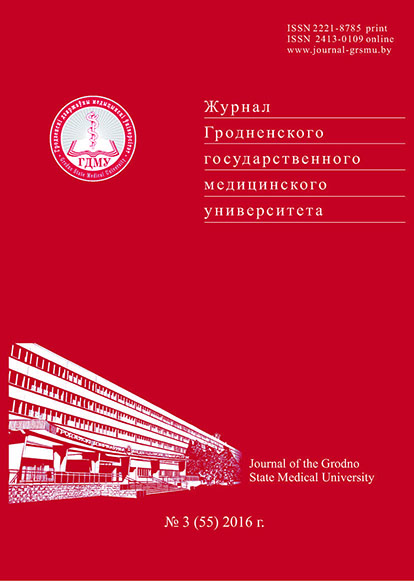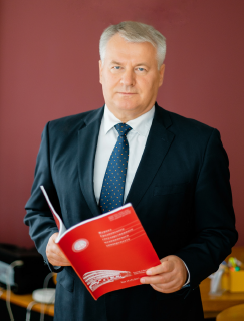ПРЕДИКТОРЫ РЕЦИДИВОВ ФИБРИЛЛЯЦИИ ПРЕДСЕРДИЙ ПОСЛЕ РАДИОЧАСТОТНОЙ АБЛАЦИИ УСТЬЕВ ЛЕГОЧНЫХ ВЕН
Аннотация
В данном обзоре представлена информация о наиболее достоверных и прогностически значимых клинических, эхокардиографических и лабораторных предикторах рецидива фибрилляции предсердий после проведения процедуры радиочастотной аблации устьев легочных вен. Рассмотренные показатели определяют вероятность долгосрочного успеха в поддержании синусового ритма и целесообразность прохождения данной процедуры пациентам с фибрилляцией предсердий.Литература
. Диагностика и лечение фибрилляции предсердий / Национальные рекомендации / Под ред.: А. Г. Мрочек, А. Г. Булгак, В. А. Снежицкий, А. Р. Часнойть, Д. Б. Гончарик, В. И. Севрукевич – Минск, «Профессиональ- ные издания». – 2013. – 123 с.
Снежицкий, В. А. Функция эндотелия при пароксизмальной фибрилляции предсердий / В. А. Снежицкий, М. С. Дешко // Журнал ГрГМУ. – 2011. – № 1. – С. 28-31.
Снежицкий, В. А. Особенности структурно-функционального ремоделирования миокарда у пациентов с пароксизмальной и персистирующей формами фибрилляции предсердий / В. А. Снежицкий, Е. С. Яцкевич // Журнал ГрГМУ. – 2013. – № 3. – С. 92-94.
Снежицкий, В. А. Влияние альдостерона и его антагонистов на ремоделирование миокарда у пациентов с фибрилляцией предсердий / В. А. Снежицкий, Е. С. Яцкевич // Журнал ГрГМУ. – 2012. – № 4. – С. 5-8.
A roadmap to improve the quality of atrial brillation management: proceedings from the fth Atrial Fibrillation Network/European Heart Rhythm Association consensus conference / P. Kirchhof [et al.] // Europace. – 2015. – Vol. 18, № 1. – P. 37-50.
Amiodarone for Treatmet of Persistent Atrial Fibrillation in Patients with Congestive Heart Failure and an Implanted Devicel: Results from the AATAC Multicenter Rndomized Trial / L. Di Biase [et al.] // J of AHA CIRCULATION. – 2016. – Vol. 133, № 17. – P.1637-1644.
Atrial fibrosis in atrial fibrillation pre-ablation assessed by CMR: impact in aial size and function? / A. Almeida [et al.] // Journal of Cardiovascular Magnetic Resonance. – 2011. – Vol. 13, № 1. – P. 259.
Cardiac Fibrosis in Patients with Atrial Fibrillation. Mechanisms and Clinical Implications / M. S. Dzeshka [et al.] // Journal of the American College of Cardiology. – 2015. – Vol. 66, № 8. – P. 943-959.
Cardiovascular magnetic resonance assessment of left atrial volumes and function in patients with persistent atrial fibrillation before and after ablation therapy / L. K. Tan [et al.] // Journal of Cardiovascular Magnetic Resonance. – 2013. – Vol. 15, № 1. – P. 98.
Chen, S. Should rhythm control be preferred in younger atrial fibrillation patients? / S. Chen, Y. Yin, M. W. Krucoff // J Interv Card Electrophysiol. – 2012. – Vol. 35, № 1. – P. 71-80.
Comparison of left atrial dimensions in CT and echocardiography as predictors of long-term success after catheter ablation of atrial fibrillation / S. Nedios [et al.] // J Interv Card Electrophysiol. – 2015. – Vol. 43, № 3. – P. 237-244.
Comprehensive risk reduction in patients with atrial fibrillation: emerging diagnostic and therapeutic options — a report from the third Atrial Fibrillation Competence NETwork / European Heart Rhythm Association consensus conference / P. Kirchhof [et al.] // Europace. – 2012. – Vol. 14, № 1. – P. 8–27.
Heijman, J. Irregular rhythm and atrial metabolism are key for the evolution of proarrhythmic atrial remodeling in atrial brillation / J. Heijman, D. Dobrev // Basic Res Cardiol. – 2015. – Vol. 110, № 4. – P. 1-5.
Improvement of cerebral oxygen saturation after successful electrical cardioversion of atrial brillation / A. Wutzler [et al.] // Europace. – 2014. – Vol. 16, № 2. – P. 189–194.
Increased levels of inflammatory and extracellular matrix turnover biomarkers persist despite reverse atrial structural remodeling during the first year after atrial fibrillation ablation / N. Sasaki [et al.] // J Interv Card Electrophysiol. – 2014. – Vol. 39, № 3. – P. 241–249.
Left atrial reservoir function predicts atrial fibrillation recurrence after catheter ablation: a two-dimensional speckle strain study / M. Mirza [et al.] // J Interv Card Electrophysiol. – 2011. – Vol. 31, № 3. – P. 197–206.
Left atrial size and function by three-dimensional echocardiography to predict arrhythmia recurrence after rst and repeated ablation of atrial brillation / S. Montserrat [et al.] // European Heart Journal – Cardiovascular Imaging. – 2014. – Vol. 15, № 5. – P. 515–522.
Left atrial volume measurements before and after left atrial ablation for the treatment of atrial fibrillation / J. Walker [et al.] // Journal of Cardiovascular Magnetic Resonance. – 2012. – Vol. 14, № 1. – P. 201.
Long-term sinus rhythm maintenance after cardioversion of persistent atrial brillation: is the treatment’s success predictable? / D. A. Kosior [et al.] // Heart andVessels. – 2006. – Vol. 21, № 6. – P. 375–381.
Novel mechanisms in the pathogenesis of atrial fibrillation: practical applications / D.H. Lau [et al.] // European Heart Journal. – 2016. – Vol. 37, № 20. – P. 1573-1581.
Predicting of atrial fibrillation development and progression: Current perspectives / K. Vlachos [et al.] // World Journal Cardiol. – 2016. – Vol. 8, № 3. – P. 267-276.
Prediction of atrial brillation recurrence after cardioversion in patients with left-atrial dilation / C. Fornengo [et al.] // European Heart Journal – Cardiovascular Imaging. – 2015. – Vol. 16, № 3. – P. 335–341.
Rich, M. W. Epidemiology of atrial fibrillation / M. W. Rich // J Interv Card Electrophysiol. – 2009. – Vol. 25, № 1. – P. 3–8.
Speckle echocardiographic left atrial strain and stiffness index as predictors of maintenance of sinus rhythm after cardioversion for atrial fibrillation: a prospective study / A. Shaikh [et al.] // Cardiovascular Ultrasound J. – 2012. – Vol. 10, № 1. – P. 48.
2012 HRS/EHRA/ECAS expert consensus statement on catheter and surgical ablation of atrial fibrillation: recommendations for patient selection, procedural techniques, patient management and follow-up, definitions, endpoints, and research trial design / H. Calkins [et al.] // J Heart Rhytm. – 2012. – Vol. 9, № 4. – P. 632-696.
Uijl, D. W. Left atrial size as a predictor of successful radiofrequency catheter ablation for atrial brillation / D. W. den Uijl, J. J. Bax // Europace. –2009. – Vol 11, № 10. – P. 1255–1256.
Why atrial fibrillation recurs in patients who obtained current ablation endpoints with longstanding persistent atrial fibrillation / L. Zhao [et al.] // J Interv Card Electrophysiol. – 2013. – Vol. 37, № 3. – P. 283–290.
Wijesurendra, R. S. Atrial brillation: effects beyond the atrium? / R. S. Wijesurendra, B. Casadei // Cardiovascular Research. – 2015. – Vol. 105, № 3. – P. 238–247.
Zimetbaum, P. Restoring Normal Sinus Rhythm in Atrial Fibrillation: Evidence from Pharmacologic Therapy and Catheter Ablation Trials / P. Zimetbaum // Current Cardiology Reports. – 2006. – Vol. 8, № 5. – P. 377–386.































